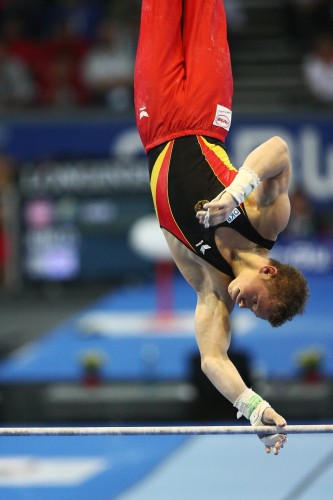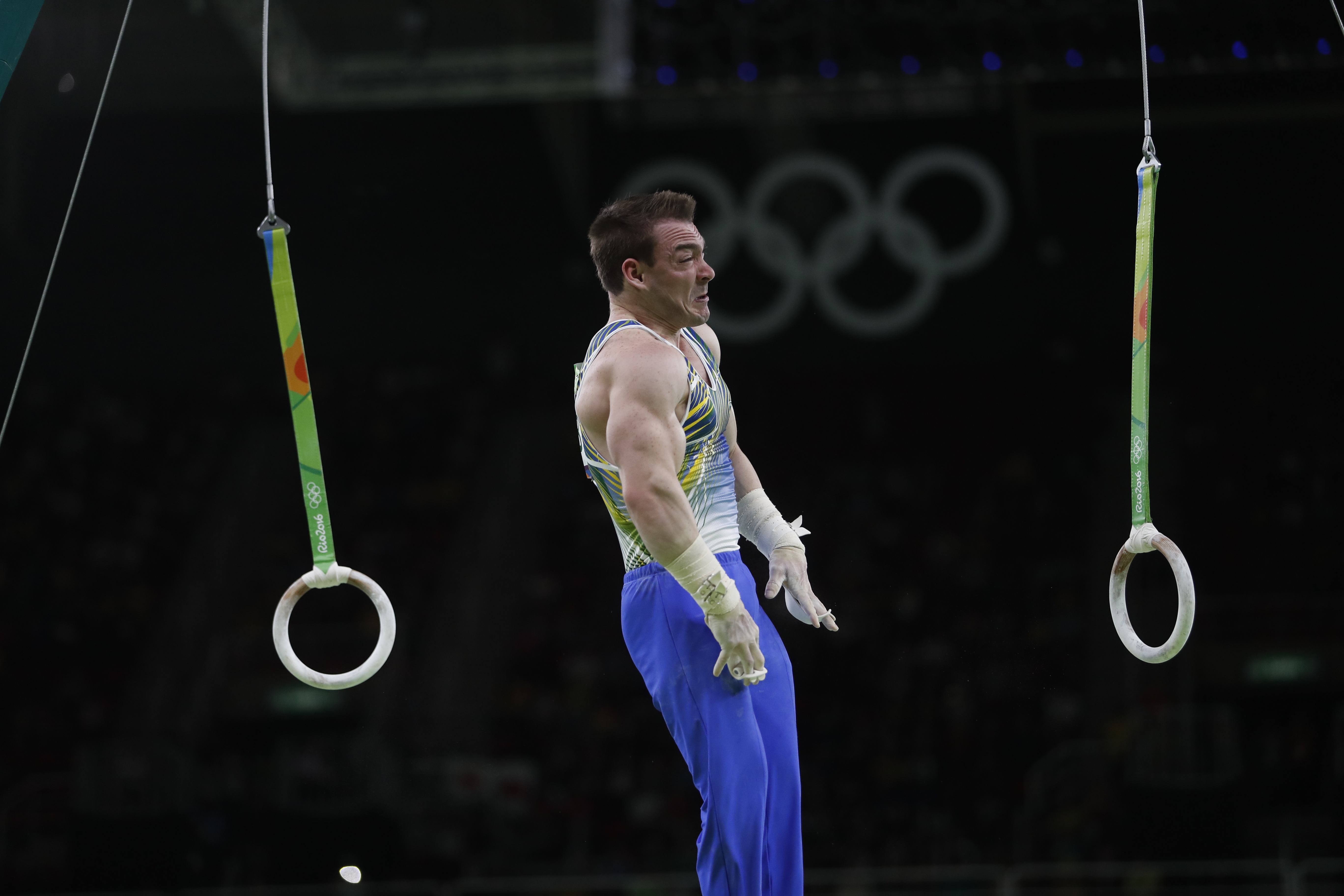|
Giant (gymnastics)
A giant is an artistic gymnastics skill in which a gymnast rotates 360 degrees around an axis while in a fully extended position. It is performed on the uneven bars in women's artistic gymnastics and on the parallel bars, horizontal bar, and rings Ring may refer to: * Ring (jewellery), a round band, usually made of metal, worn as ornamental jewelry * To make a sound with a bell, and the sound made by a bell :(hence) to initiate a telephone connection Arts, entertainment and media Film and ... in men's artistic gymnastics. Technique The gymnast begins in a handstand position. With legs together, toes pointed, and body fully extended, the feet begin to descend. The upper body hollows very slightly until the gymnast passes through horizontal. USA Gymnastics ... [...More Info...] [...Related Items...] OR: [Wikipedia] [Google] [Baidu] |
Artistic Gymnastics
Artistic gymnastics is a discipline of gymnastics in which athletes perform short routines on different apparatuses. The sport is governed by the Fédération Internationale de Gymnastique (FIG), which designs the Code of Points and regulates all aspects of elite international competition. Within individual countries, gymnastics is regulated by national federations like British Gymnastics and USA Gymnastics. Artistic gymnastics is a popular spectator sport at many competitions, including the Summer Olympic Games. History The gymnastic system was mentioned in writings by ancient authors, including Homer, Aristotle, and Plato. It included many disciplines that later became independent sports, such as swimming, racing, wrestling, boxing, and horse riding. It was also used for military training. In its present form, gymnastics evolved in Bohemia and what is now known as Germany at the beginning of the 19th century. The term "artistic gymnastics" was introduced to distinguish fr ... [...More Info...] [...Related Items...] OR: [Wikipedia] [Google] [Baidu] |
Uneven Bars
The uneven bars or asymmetric bars is an artistic gymnastics apparatus. It is made of a steel frame. The bars are made of fiberglass with wood coating, or less commonly wood. The English abbreviation for the event in gymnastics scoring is UB or AB, and the apparatus and event are often referred to simply as "bars". The bars are placed at different heights and widths, allowing the gymnast to transition from bar to bar. A gymnast usually adds white chalk to the hands so that they can grip the bar better. The apparatus Uneven bars used in international gymnastics competitions must conform to the guidelines and specifications set forth by the International Gymnastics Federation Apparatus Norms brochure. Several companies manufacture and sell bars, including AAI in the United States, Jannsen and Fritsen in Europe, and Acromat in Australia. Many gyms also have a single bar or a set of uneven bars over a loose foam pit or soft mat for learning new skills to provide an additional le ... [...More Info...] [...Related Items...] OR: [Wikipedia] [Google] [Baidu] |
Parallel Bars
Parallel bars are floor apparatus consisting of two wooden bars slightly over long and positioned at roughly head height. Parallel bars are used in artistic gymnastics and also for physical therapy and home exercise. Gymnasts may optionally wear grips when performing a routine on the parallel bars, although this is uncommon. Apparatus The apparatus consists of two parallel bars that are held parallel to, and elevated above, the floor by a metal supporting framework. The bars are composed of wood or other material, with an outer coating of wood. The vertical members of the supporting framework are adjustable so the height of the bars above the floor and distance between the bars can be set optimally for each gymnast. Dimensions *Bar length: ± *Bar rounded profile: ± vertical by ± horizontal *Bar width: ± *Height of bar from floor: ± *Distance between bars: – (adjustable) History The parallel bars (in German ''Barren'') were invented by Friedrich Ludwi ... [...More Info...] [...Related Items...] OR: [Wikipedia] [Google] [Baidu] |
Horizontal Bar
The horizontal bar, also known as the high bar, is an apparatus used by male gymnasts in artistic gymnastics. It traditionally consists of a cylindrical metal (typically steel) bar that is rigidly held above and parallel to the floor by a system of cables and stiff vertical supports. Gymnasts typically wear suede leather grips while performing on the bar. Current elite-level competition uses a stainless steel core rail. The gymnastics elements performed on the horizontal bar are regulated by a Code of Points. A bar routine, which is a sequence of several bar skills, usually includes giants with various grips (overgrip, undergrip, dorsal grip, mixed grip), in-bar work, turns, release and regrasp skills, and a dismount. The horizontal bar is often considered one of the most exciting gymnastics events due to the power exhibited by gymnasts during giant swings and spectacular aerial releases and dismounts that often include multiple flips or twists and, in some cases, airborne tr ... [...More Info...] [...Related Items...] OR: [Wikipedia] [Google] [Baidu] |
Rings (gymnastics)
The rings, also known as still rings (in contrast to flying rings), is an artistic gymnastics apparatus and the event that uses it. It is traditionally used only by male gymnasts, due to its extreme upper body strength requirements. Gymnasts often wear ring grips while performing. The apparatus The apparatus consists of two rings that hang freely from a rigid metal frame. Each ring is supported by a strap, which in turn connects to a steel cable that is suspended from the metal frame. The gymnast, who grips one ring with each hand, must control the movement of the rings and his or her body movements at all times. Dimensions The measurements of the standard apparatus are specified by Fédération Internationale de Gymnastique (FIG) in its ''Apparatus Norms'' document: * Inner diameter: ± * Diameter of profile: ± * Distance from point of attachment to lower inner side of the rings: ± * Distance between two points of attachment: ± Routines An exercise on rings ... [...More Info...] [...Related Items...] OR: [Wikipedia] [Google] [Baidu] |
Federation Internationale De Gymnastique
The International Gymnastics Federation (French: Fédération Internationale de Gymnastique, FIG) is the body governing all disciplines of competitive gymnastics. Its headquarters is in Lausanne, Switzerland. It was founded on July 23, 1881, in Liège, Belgium, making it the world's oldest existing international sports organisation. Originally called the European Federation of Gymnastics, it had three member countries—Belgium, France and the Netherlands—until 1921, when non-European countries were admitted and it received its current name. The federation sets the rules, known as the Code of Points, that regulate how gymnasts' performances are evaluated. Seven gymnastics disciplines are governed by the FIG: artistic gymnastics, further classified as men's artistic gymnastics (MAG) and women's artistic gymnastics (WAG); rhythmic gymnastics (RG); aerobic gymnastics (AER); acrobatic gymnastics (ACRO); trampolining (TRA); Double mini trampoline (DMT), tumbling (TUM) and park ... [...More Info...] [...Related Items...] OR: [Wikipedia] [Google] [Baidu] |
Code Of Points (artistic Gymnastics)
The ''Code of Points'' is a rulebook that defines the scoring system for each level of competition in gymnastics. There is not a universal international ''Code of Points'', and every oversight organization — such as the FIG (Fédération Internationale de Gymnastique), NCAA Gymnastics, and most national gymnastics federations — designs and employs its own unique ''Code of Points''. The FIG Code of Points The FIG Code of Points is defined in a public document provided by the Federation. Gymnasts competing at lower levels or outside the FIG's jurisdiction (e.g., NCAA gymnastics and local club teams) may not be scored according to the FIG code. 2006 Revised Code In 2006, the ''Code of Points'' and the entire gymnastics scoring system were completely overhauled. The change stemmed from the judging controversy at 2004 Olympics in Athens, which brought the reliability and objectivity of the scoring system into question, and arguments that execution had been sacrificed for diff ... [...More Info...] [...Related Items...] OR: [Wikipedia] [Google] [Baidu] |




